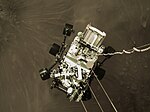C/2014 OG392 (PanSTARRS)
 | |
| Discovery | |
|---|---|
| Discovered by | Pan-STARRS |
| Discovery date | 28 July 2014 |
| Orbital characteristics | |
| Epoch | 2020-12-17 (2459200.5) |
| Observation arc | 9.3 years |
| Orbit type | Centaur / Chiron-type |
| Aphelion | 14.463 AU |
| Perihelion | 9.9697 AU (near Saturn's distance) |
| Semi-major axis | 12.216 AU |
| Eccentricity | 0.18389 |
| Orbital period | 42.7 yr |
| Inclination | 9.0333° |
| Last perihelion | 29 July 1979[1] |
| Next perihelion | 29 November 2021[1] |
| TJupiter | 3.4 |
| Earth MOID | 8.99 AU (1.345 billion km) |
| Jupiter MOID | 5.08 AU (760 million km) |
| Physical characteristics | |
| Dimensions | 20 km (albedo=0.1)[2] Absolute magnitude: H=10.8 (MPC) H=11.3 (corrected)[2] |
C/2014 OG392 (PanSTARRS) is a comet discovered as a centaur on 28 July 2014 when it was 11.5 AU (1.72 billion km) from the Sun and had an apparent magnitude of 21.[3] The comet was relatively easier to detect at this distance because the nucleus is estimated to be 20 km in diameter.[2]
DECam images from 2017 of the comet at 10.6 AU (1.59 billion km) from the Sun showed activity likely produced by carbon dioxide (CO2) and/or ammonia (NH3) sublimation (off-gassing).[2]
Clones of the orbit of C/2014 OG392 estimate a dynamic lifetime (amount of time in the current orbit) of 13 thousand to a million years.[2]
Perihelion (closest approach to the Sun) takes place not far from Saturn's orbit with a Saturn minimum orbit intersection distance of 0.9 AU (130 million km);[4] for example on 29 September 2231 at about 0.934 AU (139.7 million km) ±1 million km from Saturn.[5]
C/2014 OG392 will come to opposition on 1 November 2021 in the constellation of Cetus when it will have a solar elongation of 170 degrees. Numerical integration shows the comet last came to perihelion in late July 1979 and will next come to perihelion on 29 November 2021.[1]
References
[edit]- ^ a b c JPL Horizons Observer Location: @sun (Perihelion occurs when deldot changes from negative to positive.)
- ^ a b c d e Chandler, Colin; Kueny, Jay; Trujillo, Chad; Trilling, David; Oldroyd, William (2020). "Cometary Activity Discovered on a Distant Centaur: A Nonaqueous Sublimation Mechanism". The Astrophysical Journal. 892 (2): L38. arXiv:2003.04904. Bibcode:2020ApJ...892L..38C. doi:10.3847/2041-8213/ab7dc6. S2CID 212657575.
- ^ "MPEC 2020-U241 : COMET C/2014 OG392 (PANSTARRS)". IAU Minor Planet Center. 2020-10-27. Retrieved 2021-01-15. (CK14Od2G)
- ^ "2014 OG392 (PANSTARRS)". Minor Planet Center. Retrieved 2021-01-15.
- ^ JPL Horizons Observer Location: @699 Table Settings: 20,39 (Uncertainty is 3-sigma.)
External links
[edit]- C/2014 OG392 ( PanSTARRS ) – Seiichi Yoshida



